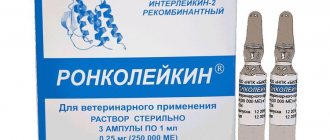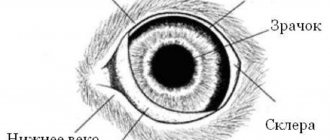Doses and procedure for using Tsiprovet eye drops in veterinary medicine
Ciprovet eye drops are instilled according to the instructions for use.
into the conjunctival cavity of the affected eye of animals, 1–2 drops four times a day for 7–14 days until clinical recovery. If there is abundant purulent or mucopurulent discharge, instill 3-4 drops of the drug, then carefully remove all discharge and crusts with a gauze swab. After this, 1-2 drops of the drug are instilled.
CIPROVET should be administered to animals at the following intervals, even at night:
The drug must be dripped more often than indicated in the instructions for use. On the first day, place 2 drops into the affected eye every 15 minutes for the first six hours, then 2 drops into the affected eye every 30 minutes for the rest of the day.
On the second day, instill 2 drops into the affected eye every hour.
From the third to the fourteenth day, apply two drops to the affected eye every 4-6 hours.
Eye drop solution
Tsiprovet eye drop solution looks like a clear, colorless and odorless liquid. The manufacturer packages the solution in plastic or glass bottles of 1, 5 and 10 ml. Original Tsiprovet drops are packaged one at a time in cardboard boxes.
Sediment, turbidity and impurities in the solution are a sign that the medicine is not suitable for use.
Indications
Tsiprovet drops are used to suppress harmful microflora in the eyes.
"Tsiprovet" is prescribed for cats if they are diagnosed with:
- acute, sluggish or purulent inflammation of the cornea of the eye, the mucous membrane of the eyelids;
- acute or chronic form of inflammation of the conjunctiva of the eye;
- mechanical damage to the eyes (injuries, punctures, etc.);
- ulcerative lesions of the surface of the cornea or the inside of the eyelids;
- inflammatory processes in the iris that are caused by bacteria.
Ciprovet drops are used for cats that are preparing for or have undergone eye surgery, as a prophylaxis against infectious inflammatory processes.
The drops cost about 135 rubles.
Contraindications
The Tsiprovet eye drop solution acts exclusively locally. It is not absorbed into the blood or lymph and its action is limited to the structures of the eye. Therefore, there are few restrictions on its use compared to tablets.
Ciprovet drops should not be used for cats with increased susceptibility to fluoroquinolone antibiotics (ciprofloxacin, ofloxacin, moxifloxacin).
If Ciprovet drops are prescribed for cats for the first time and they have not been given antibiotics of a similar composition before, it is necessary to check whether there is a reaction to the drug. To do this, the cat is given one drop of the solution and observed for 20 minutes. If after this time the redness does not increase and the cat is not worried, the use of the medicine is safe.
Do not use Tsiprovet drops for kittens that are less than a week old.
After using a full dose of the drug, the cat may feel a burning sensation - rub its eyes with its paw or rub its head against other objects. Unpleasant sensations and lacrimation usually go away on their own after 5-7 minutes.
If the cat continues to worry for a longer period of time, you should rinse the treated eye with warm, sterile saline and alert your veterinarian.
Tsiprovet should be used for cats with pathologies of the blood supply to the brain with caution and under the supervision of a veterinarian.
The active ingredient "Tsiprovet" is not stable and is easily destroyed, so it is important not to mix it with other medications. Ciprofloxacin loses its effectiveness in an acidic environment after contact with drugs that contain various metals.
Usage diagram
Due to the instability of ciproflosacin, Ciprovet drops for cats are used no earlier than 5 minutes after using other medications.
Typically, “Tsiprovet” for cats is dripped into the affected eye 4-5 times a day, 1 drop at a time, trying to get under the eyelid. Afterwards, cover the treated eye with your hand so that the medicine is distributed evenly.
You can use other drops 5–7 minutes after Tsiprovet.
In acute cases, you can apply the medicine more often, up to 8 times a day.
If there is a lot of mucus or pus in the sore eye, before dropping Ciprovet, the eye is washed with warm saline solution and wiped to clean it as much as possible. After such preparation, 3 drops of medicine are dripped into the eye, blotted with a sterile napkin and another 1 drop is added.
Like many pets, cats are prone to eye inflammation. Active cats can fight and injure each other; pets walking outside can easily pick up various infections. Ciprovet for cats, an easy-to-use and effective drug, can help treat the eyes. The product is suitable for ailments of various natures, it has almost no contraindications and is easily tolerated by animals.
Description of the drug
Ciprovet is used to treat the eyes of cats of various types.
Ciprovet contains an aqueous solution of the antibiotic ciprofloxacin (0.45%) and additional components. The drug has a complex effect on pathogenic bacteria: Staphylococcus aureus, microplasmas, Pseudomonas aeruginosa, chlamydia. The rapid destruction of the DNA structure by ciprofloxacin causes the death of microorganisms. An additional advantage of the drug is a persistent therapeutic effect that allows you to avoid relapses.
The medicine is available in the form of a colorless transparent solution, packaged in glass or soft polyethylene bottles. The price of the drug in a plastic bottle is about 130 rubles. Ciprovet can be purchased at a veterinary pharmacy or clinic without a prescription. Before use, consultation with your veterinarian is recommended.
Citrovet is prescribed for eye diseases of various natures. It is effective for therapeutic and prophylactic purposes for:
- acute and chronic conjunctivitis;
- keratitis;
- corneal ulcers;
- blepharitis;
- eye infection;
- septic iridocyclitis;
- inflammatory diseases.
Tsiprovit can be used to treat eye injuries with damage to the cornea or eyelids, when foreign bodies get into the eyes. Used for recovery after eye surgery, as well as in the preoperative period to prevent complications.
Often Ciprovet is prescribed in cases where other drugs do not have the desired effect.
Tsiprovet is effective for therapeutic and prophylactic purposes
Tsiprovet in a plastic bottle is equipped with a convenient built-in dispenser, suitable for instillation. During the procedure, you should not touch the end of the bottle to the cornea or eyelid. To work with the medicine in a glass bottle sealed with a rubber stopper, you will need a pipette.
The standard course of treatment lasts 1-2 weeks and involves using the medicine 4 times a day. The drug is instilled into the affected eye, 1 drop at a time. To prevent drops from flowing out, you need to fix the animal’s head with your hands, lifting it. In case of heavy purulent discharge, it is recommended to release 3-4 drops into the affected eye, wait a little, and then remove the softened crusts, pus and other contaminants with a clean, damp swab. After this, you need to release 1 more drop of Tsiprovet into the cleaned eye.
After the end of the cycle, it is recommended to take a break. If recovery does not occur, treatment can be repeated. In individual cases, the veterinarian may give other recommendations depending on the picture of the disease. It is not recommended to interrupt the prescribed course.
If severe severe redness of the eyes is observed, it is better to stop treatment
Ciprovet is considered a universal safe drug. Can be used for pregnant and lactating cats, as well as kittens over seven days of age. An individual allergic reaction may be a contraindication, but this is extremely rare. The drug cannot be used in cases of cerebral circulation disorders, and it is not recommended for newborn kittens.
We suggest you read: Diabetes mellitus in cats, symptoms and treatment
The following are noted as side effects:
- increased tearfulness;
- burning;
- redness of the eyes.
The animal may experience unpleasant sensations for several minutes after instillation, then they pass. If severe irritation with increasing itching is observed, it is better to stop the course and consult a doctor.
If several eye medications are prescribed, they should be instilled at intervals of 5-10 minutes.
Storage conditions
The shelf life of Tsiprovet is 2 years from the date of manufacture indicated on the bottle. After each use, the bottle must be tightly closed. It is recommended to store the drug in a place protected from light, away from food. Can be stored on the bottom shelf of the refrigerator. Before use, the bottle, taken out of the refrigerator, must be warmed in the palms of your hands and only then begin instillation.
Cat owners who have used Ciprovet leave only positive reviews
Pauline. I have a white cat, unfortunately, purulent discharge from the eyes occurs often. From time to time, reddish tear grooves are visible on the fur. The veterinarian prescribed different medications, but it was Tsiprovet that helped. True, the cat had to be patient; apparently, after the instillation he experienced discomfort. I took one course and my eyes stopped watering!
Elena. My cat was prescribed Ciprovet after an injury. At the dacha, the cat got into a fight, injured his eyelid, and his eye began to fester. The doctor advised rinsing the eye with drops and a cotton swab, and then adding another drop. The cat endured, although he was probably in pain. The effect was felt after 3 days of procedures, after 7 days the inflammation disappeared.
However, a week after stopping treatment, the eye festered again, and the course had to be repeated. The procedure is not easy, the cat avoided instillation in every possible way, but the drops really helped him. A big plus is the low price and convenient soft bottle with a screw cap. I dropped the bottle a couple of times, nothing spilled. I recommend the drops to everyone, they definitely won’t do any harm.
Anya. I treated a kitten picked up at the dacha with Tsiprovet. His eyes constantly festered, we tried some other drops from the pet store, but they didn’t help. In desperation I bought Ciprovet. And he helped! Not immediately, but the eyes cleared up, the redness in the eyelids disappeared, the kitten stopped scratching its face all the time and clearly began to feel better.
Cats, regardless of whether they walk freely on the street or do not leave their house or apartment, are susceptible to bacterial, viral, and parasitic diseases of various pathogenesis and etiology. Your favorite cat can catch a dangerous infection through contact, nutritional, or aerogenic (airborne) routes. In this case, bacteria can enter the house on clothes, the soles of the owners’ shoes, and household items.
Breeders of furry purrs must closely monitor the health and behavior of their pets. But if it so happens that your cat gets sick with a viral-bacterial infection, in order to avoid the development of serious complications, you should immediately contact your veterinarian. After a routine examination and comprehensive diagnostics, the four-fingered patient will be prescribed effective therapeutic therapy.
Contraindications to the use of Ciprovet eye drops in animals
- Hypersensitivity to the active substance - ciprofloxacin or any of the excipients.
- Hypersensitivity to quinolones.
For external use only on the eyeball.
Clinical experience in young animals, especially neonates, is very limited. The use of CIPROVET eye drops in newborns is not recommended as side effects have not been assessed in this group of patients.
Serious and sometimes fatal hypersensitivity reactions (anaphylactic), some after the first dose, have been observed in animals treated with systemically administered quinolones. Some reactions were accompanied by cardiovascular collapse, loss of consciousness, swelling of the throat or face, shortness of breath, urticaria and itching.
Serious acute hypersensitivity reactions to Ciprovet may require immediate emergency treatment. Oxygen and mechanical ventilation should be provided to animals when clinically indicated.
CIPROVET eye drops should be discontinued at the first appearance of skin rash or any other signs of hypersensitivity in animals.
As with all antibacterial drugs, long-term use may lead to overgrowth of resistant bacterial strains or fungi. If an animal develops a superinfection, appropriate therapy should be initiated.
Tendon inflammation and rupture may occur during systemic fluoroquinolone therapy, including ciprofloxacin, especially in elderly patients and those being concomitantly treated with corticosteroids. Therefore, treatment with CIPROVET eye drops should be stopped at the first signs of tendon inflammation in animals.
In animals with corneal ulcers and frequent use of CIPROVET eye drops, local white eye discharge (drug residues) was observed, which disappeared after prolonged use of CIPROVET eye drops. The sediment does not interfere with the further use of CIPROVET eye drops and does not have a negative effect on the clinical course of the recovery process. The appearance of sediment occurred within 24-7 days after the start of therapy.
CIPROVET eye drops contain benzalkonium chloride
, which may cause eye irritation in animals.
Indications for veterinary use of the drug Ciprovet
The active substance Ciprovet (ciprofloxacin hydrochloride) is an antibiotic of the fluoroquinolone group, so the drug is active against many types of bacteria:
- anthrax pathogen;
- causative agent of meningitis;
- Staphylococcus aureus (including antibiotic-resistant strains);
- saprophytic staphylococcus;
- streptococci;
- pasteurella;
- salmonella;
- Brucella;
- protea;
- Listeria monocytogenes;
- campylobacter;
- Pseudomonas aeruginosa;
- diphtheria bacillus.
The diphtheria bacillus is the causative agent of a serious infection. A strain of salmonella can cause typhus, paratyphoid and other diseases of the abdominal cavity. Staphylococcus is a bacillus that can provoke many diseases of different organs and systems. Streptococcus causes an infection that affects the respiratory and digestive system.
https://www.youtube.com/watch?v=cugQ-QsVkIU
Ciprovet tablets are prescribed for the following diseases:
- infectious lesions of the respiratory and digestive systems;
- infections of the gallbladder and genitourinary system;
- bacterial lesions of the skin and mucous membranes;
- infectious diseases of the musculoskeletal system;
- secondary infections in viral diseases.
Ciprovet drops are prescribed for the following eye ailments:
- conjunctivitis (acute and chronic) and keratoconjunctivitis;
Most often, Tsiprovet drops are used in the treatment of conjunctivitis in cats. - keratitis and blepharitis;
- corneal ulcers;
- septic iridocyclitis;
- foreign body getting into the eye;
- eye injuries.
Also, eye drops can be prescribed to prevent complications of previous ophthalmological operations.
Injections of the drug Ciprovet 5% are used for the following diseases:
- bacterial infections of the gastrointestinal tract and respiratory tract;
- diseases of the genitourinary system and mastitis-metritis-agalactia syndrome (puerperal fever);
- infectious diseases of the skin, soft tissues and joints;
- umbilical infections;
- atrophic rhinitis and bronchopneumonia;
Atrophic rhinitis in cats (when nasal discharge turns pinkish) requires treatment with antibiotics such as Ciprovet - colibacillosis;
- pasteurellosis, salmonellosis;
- secondary infections of bacterial origin.
To treat cats at home, eye drops and tablets are mainly used. Tsiprovet drops have an antiseptic and anti-inflammatory effect and are prescribed for:
- ulcerative lesions of the cornea;
- conjunctivitis;
- blepharoconjunctivitis;
- keratitis;
- septic iridocyclitis;
- blepharitis;
- after surgery, injury and foreign bodies getting into the eyes (to prevent inflammation).
READ Trontsil-k for cats: instructions for use, reviews, price
Ciprovet for cats in tablet form is prescribed when diagnosing the following groups of diseases in animals:
- respiratory system - bronchitis, tracheitis, bronchopneumonia, chronic obstructive pulmonary disease and tonsillitis;
- gastrointestinal tract and digestive glands - colibacillosis, enteritis, salmonellosis, dysentery, viral hepatitis and pancreatitis;
- genitourinary system – cystitis, urolithiasis and nephritis;
- musculoskeletal system and soft tissues - purulent arthritis, osteomyelitis, phlegmon and abscesses;
- secondary infections that are complications of other diseases.
Due to the fairly high safety and good tolerability of the drug, side effects after taking it occur only in case of overdose or in the presence of contraindications. It is prohibited to give these antibiotics to animals in the following cases:
- pregnancy and lactation in cats - ciprofloxacin penetrates into milk, having a destructive effect on the formation of cartilage tissue in babies;
- the age of kittens is under 7 months or until the end of their physiological development (applies to tablets, drops are allowed to be used from the second week of life);
- chronic dysfunction of the liver and kidneys;
- pathologies of the endocrine system;
- violation of the integrity of cartilage tissue;
- diseases of the central nervous system, accompanied by spasms and convulsions;
- deficiency of the enzyme glucose-6-phosphate dehydrogenase - with this pathology, the energy reserves of the cell are reduced and red blood cells are destroyed;
- individual intolerance to antibacterial drugs of the fluoroquinolone group.
It is prohibited to take Tsiprovet simultaneously with macrolide and tetracycline antibiotics and chloramphenicol. To avoid seizures, it is not used with non-steroidal anti-inflammatory drugs.
Incorrect use of Tsiprovet provokes the following side effects:
- increased salivation;
- increased thirst;
- refusal of food;
- nausea and vomiting;
- general weakness;
- allergic manifestations - swelling and small rash on the face;
- itching, lacrimation, discomfort, hyperemia and swelling of the mucous membrane of the eyes - when using eye drops;
- impaired coordination of movements.
If side effects occur, you should immediately stop using the medication. First of all, you need to wipe your eyes with a cotton pad soaked in clean water. If, after taking an antibiotic orally, a pet develops an allergic reaction, he is given antihistamines, including those administered parenterally. Complications caused by the use of these antibiotics are reversible and quickly disappear after their discontinuation.
- gastroenteritis (including diarrhea caused by infection)
- gallbladder infection
- bone and joint infections
- food poisoning
- respiratory infections
- bronchitis
- pneumonia
- rhinitis
- skin infections such as dermatitis, cellulitis
- urinary tract infection
- cystitis
- nephritis
- prostatitis
Treatment of dogs and cats for infectious diseases of the gastrointestinal tract, respiratory tract, genitourinary system, joints, soft tissues and skin, umbilical infections, atrophic rhinitis, bronchopneumonia, colibacillosis, salmonellosis, pasteurellosis, mycoplasmosis, other primary and secondary infections of bacterial etiology, pathogens who are sensitive to ciprofloxacin.
Cattle, sheep, goats, pigs for infectious diseases of the gastrointestinal tract, respiratory tract, genitourinary system, joints, soft tissues and skin, necrobacteriosis, umbilical infections, atrophic rhinitis, bronchopneumonia, colibacillosis, salmonellosis, pasteurellosis, mycoplasmosis, mastitis syndrome -metrithalactia (MMA) and other infections whose pathogens are sensitive to ciprofloxacin.
Dairy animals, pregnant and lactating females, animals with kidney and liver diseases and disorders of the development of cartilage tissue, with damage to the nervous system, as well as puppies and kittens until the end of the growth period. With increased individual sensitivity of the animal to fluoroquinolones. Do not use simultaneously with bacteriostatic antibiotics (chloramphenicol, macrolides and tetracyclines), theophylline and non-steroidal anti-inflammatory drugs.
For dogs and cats for therapeutic purposes for chronic and acute bacterial infections of the gastrointestinal tract, biliary tract, respiratory organs, genitourinary system, skin and soft tissues, bones and joints, as well as for secondary infections against the background of viral diseases, the pathogens of which are sensitive to ciprofloxacin .
For females during pregnancy and lactation, animals with severe developmental disorders of cartilage tissue, with damage to the nervous system, as well as puppies and kittens before the end of the growth period. It should not be used simultaneously with bacteriostatic antibiotics and non-steroidal anti-inflammatory drugs, as well as with drugs containing magnesium, aluminum and calcium cations.
Interaction with other drugs and other forms of interaction
Specific drug interaction studies have not been conducted with the ophthalmic formulation of ciprofloxacin in animals. Given the low systemic concentration of ciprofloxacin after topical application of the drug to the eyes of animals, drug interactions are unlikely.
If more than one topical ophthalmic drug is used, the drugs should be administered at least 5 minutes apart. Eye ointments should be administered last.
Release form.
- for cats and dogs of small breeds – 1 tablet per 3 kg of animal weight “Ciprovet tablets for cats and dogs of small breeds”;
- for dogs of medium and large breeds – 1 tablet per 10 kg of animal weight “Ciprovet tablets for dogs”.
READ Domestic fox or fennec fox at home
The drug is produced in two modifications - Ciprovet tablets for dogs and Ciprovet tablets for cats and small breed dogs, packaged in blister packs of 10 pieces. External packaging – cardboard box.
Ciprovet cannot be combined with the following antibiotics:
- chloramphenicol;
- tetracyclines;
- macrolides;
- theophylline;
- non-steroidal anti-inflammatory drugs;
- medications containing magnesium, calcium or aluminum cations.
Ciprovet should not be used in conjunction with bacteriostatic antibiotics.
Ciprovet drops cannot be combined with solutions with a pH level of 3–4, which are chemically or physically unstable. If, in addition to Ciprovet, other eye medications are prescribed, then they should be used at intervals of at least 5 minutes.
Tsiprovet can be combined with antiviral agents, immunomodulators and symptomatic medications:
- Suprastin;
- Kotervin;
- Gamavit;
- Milbemax;
- Fortiflora.
Allergy medications (for example, Suprastin) can be used together with antibiotics. If we are talking about diseases of the genitourinary system, then Ciprovet can be used together with diuretics, for example, Kotervin Antibiotics are well compatible with immunomodulators and vitamin complexes, such as Gamavit Ciprovet can be combined with anthelmintics, which includes Milbemax Ciprovet can be combined with probiotic preparations (one of them is Fortiflora)
Specific drug interaction studies have not been conducted with the ophthalmic formulation of ciprofloxacin in animals. Given the low systemic concentration of ciprofloxacin after topical application of the drug to the eyes of animals, drug interactions are unlikely.
If more than one topical ophthalmic drug is used, the drugs should be administered at least 5 minutes apart. Eye ointments should be administered last.
Dark glass bottle 50 ml and 100 ml.
Sick animals are prescribed “human” medications based on ciprofloxacin: eye drops Tsifran, Ciloxan, Tsipromed and tablets Tsiprolet and Ecotsifol. Taking these medications is possible only as prescribed by a specialist, when it is not possible to use a veterinary drug. If, for example, a veterinary drug based on ciprofloxacin causes an allergy in a cat, you need to replace it not with an analogue, but with another antibiotic of the fluoroquinolone group.
Animal pregnancy and the use of Ciprovet eye drops
There are no adequate data on the use of CIPROVET in pregnant animals. Studies in laboratory animals do not indicate direct harmful effects in terms of reproductive toxicity. Systemic exposure to ciprofloxacin following topical administration is expected to be extremely low.
As a precaution, it is preferable to avoid the use of CIPROVET during pregnancy unless the therapeutic benefit is expected to outweigh the potential risk to the fetus.
Undesirable effects
In clinical trials, the most common adverse drug reactions were ocular discomfort, dysgeusia, and corneal deposits.
The following undesirable effects have been noted in connection with the use of CIPROVET in ophthalmology:
- Immune system disorders
- Rare: hypersensitivity
- Nervous system disorders
- Rare: dizziness
- Eye disorders
- General: crystal deposits on the cornea, eye discomfort, eye hyperemia
- Uncommon: keratopathy, punctate keratitis, corneal infiltrates, photophobia, eyelid swelling, blurred vision, eye pain, dry eyes, eye swelling, lacrimation, eye discharge, crusting of eyelid margins, eyelid detachment, conjunctival edema, eyelid erythema
- Rare: ocular toxicity, keratitis, conjunctivitis, corneal epithelial defect, diplopia, ocular hypoesthesia, asthenopia, eye irritation, eye inflammation.
- Respiratory problems, chest and mediastinal disorders
- Rare: hypersecretion, rhinitis
- Gastrointestinal disorders
- General: dysgeusia
- Uncommon: nausea
- Rare: diarrhea, abdominal pain
- Diseases of the skin and subcutaneous tissue
- Rare: dermatitis
- Musculoskeletal system and connective tissue
- Not known: tendon disorder
Side effects in veterinary medicine
Ciprovet may cause mild to serious side effects in animals. The following list contains some key side effects that may occur while taking Ciprovet. This list does not include all possible side effects:
- nausea
- diarrhea
- vomit
- stomach upset
- ataxia
- rash
In addition, liver test results may be higher than usual. This is usually temporary, but can also be a sign of liver damage.
Serious side effects and their symptoms may include:
- Tendon rupture or swelling
- Liver damage
- Severe allergic reaction
- Seizures, tremors, or epilepsy
- Intestinal infection
Pharmacological properties of veterinary eye drops Ciprovet
Pharmacodynamic properties
Pharmacotherapeutic group - other anti-infective drugs.
Mechanism of action
According to the instructions for use, CIPROVET eye drops, solution contains the fluoroquinolone ciprofloxacin. The cidial and inhibitory activity of ciprofloxacin against bacteria results from interference with DNA gyrase, an enzyme required by bacteria for DNA synthesis. Thus, vital information from bacterial chromosomes cannot be deciphered, which causes metabolic disturbances in bacteria. Ciprofloxacin has in vitro activity against a wide range of gram-positive and gram-negative bacteria.
Contraindications and precautions
The medicine is practically safe, but has some contraindications. The main contraindications to the use of the drug are: pregnancy and lactation; serious disorders of the development of cartilage tissue; deviations from the nervous system. There are no serious consequences or complications during the use of the drug.
We suggest you read: Why a cat smells like rotten meat If your cat smells like rotten meat it needs to be treated
Some cats experience a short-lived reaction to the drug - itching and burning, which usually goes away after a few minutes. In rare cases, due to individual intolerance to the drug, the cat may begin to refuse food, vomiting and swelling of the soft tissues may occur.
In order not to interfere with absorption, the drug should not be used simultaneously with tetracyclines, NSAIDs, chloramphenicol and drugs that contain large amounts of calcium and aluminum. According to the degree of impact on the body, the drug in tablet form belongs to hazard class 3, and in the form of drops - to class 4, therefore, in moderate doses, the drug does not have a toxic effect and does not cause irritation.
There are also no teratogenic properties. When using the drug, it is important to follow generally accepted personal hygiene and safety measures. If the product gets on the skin, rinse the area with plain water. Storage conditions The medical medicine Tsiprovet is stored in sealed packaging from the manufacturer in a place inaccessible to children, away from food and protected from direct sunlight.
The storage temperature for the product in tablet form is from 0C to 25C, and for the drug in the form of drops – 5–25C. The shelf life of the drug from the date of manufacture is 4 years for tablets and 3 years for drops (subject to compliance with storage conditions). There are no special precautions required when disposing of unused expired product.
How to put drops in a cat's eyes
Visit the profile section of our Medical Examination forum or leave your feedback in the comments below. More opinions means more useful information, it will be useful to someone. If there are good and interesting videos on the topic of the article, write and I will insert them into this publication.
Ciprovet is a broad-spectrum veterinary drug that is used to treat diseases of bacterial origin. It is produced by the Russian organization NVC Agrovetzashchita LLC (Moscow region, Sergiev Posad), which specializes in medicines, vitamins and animal care products.
"Agrovetzashchita" is a research and development center that develops and produces veterinary drugs
The manufacturer of Tsiprolet has been developing unique formulas since 1993. The organization has more than 240 products, including antibiotics that are trusted not only by animal owners, but also by veterinarians.
Mechanism of resistance
Resistance to fluoroquinolones, particularly ciprofloxacin, requires significant genetic changes in one or more of five major bacterial mechanisms: a) enzymes for DNA synthesis, b) protein defense, c) cell permeability, d) drug efflux, or e) plasmid-mediated aminoglycoside 6'-N-acetyltransferase, AAC (6') - Ib.
Fluoroquinolones, including ciprofloxacin, differ in chemical structure and mode of action from aminoglycosides, β-lactam antibiotics, macrolides, tetracyclines, sulfonamides, trimethoprim and chloramphenicol. Therefore, organisms resistant to these drugs may be sensitive to ciprofloxacin.
According to the instructions for use, the species usually susceptible to Ciprovet veterinary eye drops are:
- Aerobic gram-positive microorganisms
- Corynebacterium accolens
- Corynebacterium auris
- Corynebacterium propinquum
- Corynebacterium psudodiphtheriticum
- Corynebacterium striatum
- Staphylococcus aureus (Methicillin-susceptible - MSSA)
- Staphylococcus
- Staphylococcus epidermidis (methicillin susceptible - MSSE)
- Staphylococcus aureus
- Staphylococcus saprophyticus
- Staphylococcus warneri
- Pneumococcus
- Streptococcus viridans Group
- Aerobic gram-negative microorganisms
- Acinetobacter species
- Haemophilus influenzae
- Moraxella catarrhalis
- Pseudomonas aeruginosa
- Serratia Marcescens
Learn about essential antimicrobials in animals
- Trichopolum in veterinary medicine
- Instructions for the use of the antibiotic Baytril in animals
- Metronide in veterinary medicine. Instructions for use, doses, indications and contraindications
- Use of ceftriaxone for animals
- Explore the breadth of Metrogyl's antibacterial effect in animals
- Instructions for the use of doxycycline in animals. Study the breadth of doxycycline's antibacterial effects in animals. Calculate the optimal dose of the drug for different types. Improve therapy effectiveness by 140%
- Metronidazole (Metronidazole) for animals (instructions for use in veterinary medicine, doses, indications and contraindications)
- Atovaquone (ATOVAQUONE)
- Azithromycin for veterinary use
Ciprofloxacin dosage for cats
Fortunately for pets and their owners, serious cat diseases can now be fought not just by relying on immunity. Veterinary medicine keeps up with the times, and treating animals with antibiotics has become common practice. Ciprofloxacin for cats is an effective antibacterial and antimicrobial drug for the treatment of many diseases.
- General information about ciprofloxacin
- Description of Ciprofloxacin
When treating diseases of cats and dogs, veterinarians do not always resort to antibiotics. Chemotherapy drugs of this group are prescribed in the following cases:
- Infectious lesions of the ears and eyes;
- Purulent lesions and skin infection;
- Treatment of diseases of a bacteriological nature (cystitis, piloeniphritis, pneumonia, pyometra and others);
- Diseases caused by various microorganisms - chlamydia and intestinal infections. Tuberculosis and leptospirosis, salmonellosis and pseudomonosis, staphylococcosis, enterococcal infection.
The dosage of tablets directly depends on the weight of the cat. 1 tablet is required per 3 kg of animal. It must be taken orally, once a day. The duration of treatment is determined by the treating specialist; on average, it is no more than 5 days. Drops are used several times a day (3-4) 1 drop.
How to give a pill to a cat
Pharmacokinetic properties
According to the instructions for use, CIPROVET eye drops, solution is quickly absorbed into the animal's eye after local ocular administration. Systemic levels are low after topical application. Plasma levels of ciprofloxacin in humans following 2 drops of a 0.45% ciprofloxacin solution every 2 hours for two days and then every four hours for 5 days ranged from not quantifiable (less than 1.0 ng/ml) to 4.7 ng / ml. The mean peak plasma levels of ciprofloxacin obtained in this study were approximately 450-fold lower than those obtained with a single 250 mg oral dose of ciprofloxacin. The systemic pharmacokinetic properties of ciprofloxacin have been well studied.
Ciprofloxacin is widely distributed throughout the tissues of the body.
The apparent volume of distribution at steady state is 1.7-5.0 l/kg. Binding to whey protein is 20-40%. The half-life of ciprofloxacin in serum is 3-5 hours. Both ciprofloxacin and its four main metabolites are excreted in urine and feces. Renal clearance accounts for approximately two-thirds of total serum clearance, with the remaining percentages being biliary and fecal tracts. In patients with impaired renal function, the half-life of Cyprovet is only moderately increased due to extrarenal elimination routes. Likewise, in patients with severely reduced liver function, the half-life is only slightly longer.
pharmachologic effect
The main active ingredient in the drug Ciprovet is ciprofloxacin.
It is characterized by a wide spectrum of antibacterial action, showing activity against various types of bacteria (Gram-negative and Gram-positive), for example, Streptococcus spp, Plesiomonas shigelloides and Mycobacterium spp. The essence of its action is to block the enzyme DNA gyrase, which as a result provokes a disruption of protein synthesis and the elimination of the microorganism. The drug is easily absorbed into the gastrointestinal tract and is evenly distributed throughout the body (without affecting tissues saturated with fats). The maximum intensity of the active component in the blood is detected after a few hours, and the therapeutic effect persists throughout the day.
When using the drug in the form of drops, a stable therapeutic effect is also noted, the active substance enters the cornea and chamber of the eye, has an anti-inflammatory and antibacterial effect. The medicine is excreted from the cat's body through urine and bile. Below are detailed instructions for Ciprovet eye drops.








